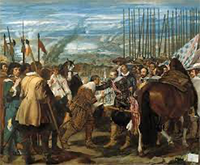King Philip IV of Spain
Part 1: Inheriting a War Philip IV was King of Spain for more than four decades in the 17th Century. Coincidentally or not, he presided over what many historians perceive to be a decline in Spanish prestige and power. He was born on April 8, 1605, in Valladolid. He was the first son born to King Philip III and Margaret of Austria. 
When young Philip was 10, he married 13-year-old Isabella of Bourbon (right), sister of France's King Louis XIII. In the same year, Philip's sister, Anne, had married King Louis himself. 
Philip III died in 1621, and his son became king. By then, the Thirty Years War had begun and Spanish forces had gained a significant victory at the Battle of White Mountain. Young Philip had earlier made the acquaintance of Gaspar de Guzmán, whose uncle Baltasar de Zúñiga had helped Cristóbal de Sandoval y Rojas oust his own father from the position of valido (royal favorite) to Philip III. Guzmán and young Philip developed a friendship that continued on into the young king's reign, with the 16-year-old Philip IV naming the 34-year-old Guzmán his principal advisor, despite the latter's having very little administrative experience. Guzmán later succeeded his father as Count Olivares and is much more well-known as just Olivares. He remained the king's valido for two decades. 
Spain had entered the Thirty Years War on the side of the Holy Roman Emperor, mainly because the emperor, Ferdinand II, was a cousin of Philip III. Spain and the Netherlands, at war since 1568, had signed the Twelve Years' Truce in 1609; when that agreement expired, the two sides returned to fighting each other (and their respective allies). Philip IV's forces enjoyed more successes in the early years of the war, particularly at Breda in 1624 (right) and at Nördlingen in 1634. The next year, however, France, after largely ignoring the conflict, waded in with a vengeance. France's King Louis XIII and his most trusted advisor, Cardinal Richelieu, were Catholic but sided with the Protestants in order to oppose the Holy Roman Empire. Richelieu feared that a Holy Roman Empire victory would leave France encircled by forces loyal to Spain and had sent large amounts of money to aid the Protestant forces in the early years of the war. As the war dragged on, both sides lost leaders, both on the field and in government. Ferdinand II died, and his son, Ferdinand III, kept up the fight, as did his successor, Leopold I, after replacing Ferdinand III. Spanish troops invaded France in 1637 and were eventually turned out. French and Spanish forces fought each other to a standstill after a handful of years. Next page > Fighting the Tide > Page 1, 2 |
|
Social Studies for Kids
copyright 2002–2025
David White




